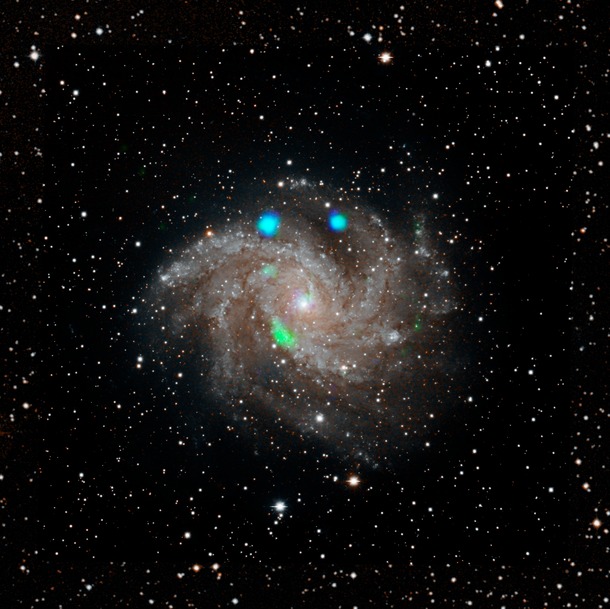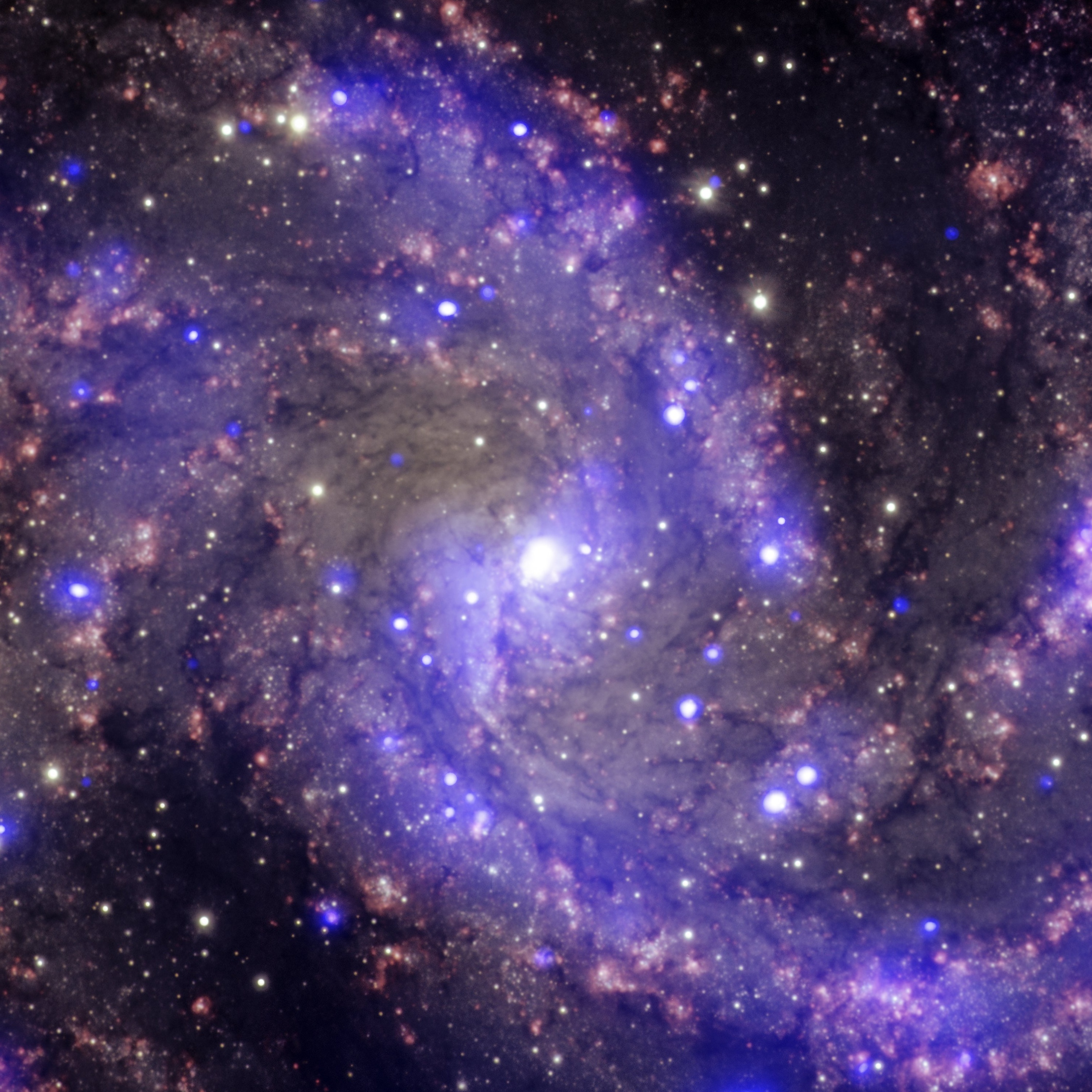A mere 10 million light-years away from the
Milky Way, NGC 6946 is an intermediate spiral galaxy with a bright nucleus nestled within the
Virgo Supercluster. Better known as the Fireworks Galaxy, a nicknamed received from the large amount of supernovae this galaxy produces, its distance from
Earth is roughly 25.2 million light years, close enough that it was at one time thought to be a part of the Local Group, but this was found to be untrue.
With a galactic diameter of around 40,000 light years, the galaxy is roughly one-third of the Milky Way's size. Although it is currently actively producing stars to this day, so much so that is considered a starburst galaxy (, it also only contains approximately half the number of stars as the Milky Way as well. When viewed from Earth-based telescopes and cameras, the galaxy is heavily obscured by interstellar matter due to its position close to the galactic plane of the Milky Way.
History
NGC 6946 was discovered on September 9th, 1798 by British Astronomer William Herschel. However, it wasn't until after some interesting x-ray findings in 2017 form NASA's NuSTAR observatory, and again in 2025 that interest in the galaxy began to greatly increase, even more so from a third event that came from the direction of the distant galaxy a few years later in the summer of 2031. This event was much closer this time, estimated to be about half the distance from NGC 6946 to the Milky Way. A fourth x-ray event was recorded at NASA's Chandra X-ray Observatory in 2035, exactly ten years after the previous one. This time, however, the event happened within our own solar system, on the planet
Neptune's moon,
Triton.
First Contact
On October 3rd, 2035, at 2:32 a.m. EST, Chandra detected an anomaly in the direction of Neptune, specifically Neptune's largest moon, Triton. A large wave of x-rays burst forth the normally icy moon, shooting across the solar system. This caused a media circus on the planet, as there was no discernible cause for the random expulsion of the high intensity x-rays from the moon. After much deliberation, and a joint effort between the United States and China, probe was built and launched within 3 years to go investigate the anomaly.

by NASA/JPL-Caltech
January 1st, 2044, only a few hours after the ball dropped in Times Square but over 9 years after the initial burst of x-rays (which had lessened but still kept relentlessly coming from the Neptunian moon), the probe reached Triton. After the prograde orbit was stabilized and all the sensors were verified, the probe's operators set about exploring the moon's surface to see if they could identify what was outputting the waves of x-rays. What was shown across the screens and TVs of millions both shocked and amazed them.
There was some sort of large, circular superstructure built on the planetside surface of the moon. It was easily over 1000 feet tall, and the inside of the circular machine showed a window into a foreign starscape, completely unrecognizable to human eyes at that time. This would be the first of many discoveries leading up to the crux
Great Realization.
Lonely No More
An initial craziness that followed this startling understanding was thrust upon humanity; A craziness that included multiple mass suicides, shootings, and other terrible acts of vandalism and terrorism as humans came to terms with the fact that they very likely had never been alone in the universe as had been previously suspected. Someone or, more likely, *something* was out there as well, and it apparently had sufficiently advanced technology to cross interstellar space, something that humans were closer than they realized to having access to.
Having eventually gotten over the initial shock of learning that somewhere, apparently now in our solar system their existed extraterrestrial life, plans for the exploration of the superstructure on Triton, now referred to as
UTS-1, were quickly underway.
Whether it was fear or the thirst for the potential knowledge this alien structure held we will never know, but in a surprising act of comradery, the US, Canada, Russia, China and Japan all joint forces to establish
USHER, an international space administration centered explicitly on the exploration and study of the newfound structure on Triton as well as whoever or whatever might have created it.
Study of the structure went on for decades, though unfortunately less was found discovered from it than they had hoped. It took 12 years after the initial probe arrived for before the first manned crew was able to arrive, and in that time the waygate still kept the majority of its secrets. Humanity had no idea what the structure actually *was*, much less what its intended function was. In It was through the hard work and efforts of the men and women in USHER that, in the winter of the year 2057 AD, first contact with extraterrestrials was made.
One Small Step For Man
In a series of
mission logs from Captain Jonathon Hartless, the leader of the 2057 mission that changed mankind's history as we know it, Hartless describes multiple encounters of the course of a week of what he thought at first was a visual illusion or a mirage. As the logs go on, however, we discover that it is, in face, a member of the
Ryzalam trying to make contact with the ship.
NGC 6946 was first visited by humans in until 2085 AD, 7 years after humanity first spoke with the Ryzalam on Triton, and 41 years after the initial camera probe that discovered the structure had arrived.
The only sentient species that were natives to this galaxy, the Ryzalam, were recently made extinct through the use of a
Dmitrievich Burrowing Mine, effectively causing a genocide of the race and violating multiple international and interplanetary edicts and regulations, as well as dozens of
FOX wartime policies regarding restricted weapon usage.
Notable Planetary Systems
N6946-BH3



Comments